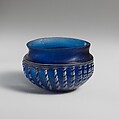Glass ribbed bowl
Translucent cobalt blue; trail in opaque white.
Knocked-off, uneven rim; deep concave neck; narrow sloping shoulder; squat globular body curving in to flat bottom.
Thick trail wound spirally around bottom, then becoming finer as it continues up side, ending on edge of shoulder; sides tooled into twenty-four, unevenly-spaced, vertical ribs.
Intact; pinprick and some elongated bubbles; dulling, slight pitting, faint iridescence, and weathering of trail around side between ribs.
Ribbed bowls like these, often decorated with opaque white trails, were very popular throughout the Roman world and may be seen as successors to the cast ribbed bowls of the first century B.C. to the early first century A.D. A major center of production was probably located in Northern Italy or the province of Pannonia along the main route to the Danube frontier.
This image cannot be enlarged, viewed at full screen, or downloaded.

